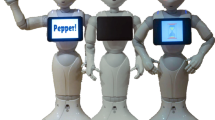Abstract
Recently, with the development of the robot industry, various types of robots have been developed, and robots are being used in various fields as well as industrial fields. Many studies show the possibility of extending the development direction of such companion robots to education and show many research cases. Especially for children, social interaction training during infancy and childhood has a great impact as an adult. Among them, social initiation, which means trying social interaction first, requires sufficient training and interaction experience. So, it is necessary to understand the meaning of social initiation in which the robot attempts social interaction in a situation where the user is concentrating on the task. Learning from robots is effective for infants and young children, and the intimacy formed by social initiation of robots can maximize the learning effect. For those reason, in a 1:1 interaction between the user and the robot, we understand how social initiation of the robot can attract the user’s attention when the user is concentrating on the task, and what form of social initiation forms the social intimacy between the user and the robot. In particular, this study conducted an experiment focusing on the change in user’s interest and liking according to the language type of the robot among the social initiation types, and the results were derived. This study examined the characteristics of robot social initiation targeting adults first and further work is planned to extend the result to children.
Access this chapter
Tax calculation will be finalised at checkout
Purchases are for personal use only
Similar content being viewed by others
References
Wang, T.M., Tao, Y., Liu, H.: Current researches and future development trend of intelligent robot: a review. Int. J. Autom. Comput. 15(5), 525–546 (2018)
Fronemann, N., Pollmann, K., Loh, W.: Should my robot know what's best for me? Human–robot interaction between user experience and ethical design. AI & Soc. 37(2), 517 -533 (2022)
Serholt, S., Barendregt, W.: Robots tutoring children: longitudinal evaluation of social engagement in child-robot interaction. In: Proceedings of the 9th Nordic Conference on Human-Computer Interaction, pp. 1–10 (2016)
Lytridis, C., Bazinas, C., Papakostas, G.A., Kaburlasos, V.: On measuring engagement level during child-robot interaction in education. In: Merdan, M., Lepuschitz, W., Koppensteiner, G., Balogh, R., Obdržálek, D. (eds.) Robotics in Education. RiE 2019. Advances in Intelligent Systems and Computing, vol. 1023, pp 3–13. Springer, Cham (2020). https://doi.org/10.1007/978-3-030-26945-6_1
Kim, S., Hirokawa, M., Matsuda, S., Funahashi, A., Suzuki, K.: Smiles as a signal of prosocial behaviors toward the robot in the therapeutic setting for children with autism spectrum disorder. Front. Robot. AI 8 (2021)
Willemse, C.J., Toet, A., Van Erp, JB.: Affective and behavioral responses to robot-initiated social touch: toward understanding the opportunities and limitations of physical contact in human–robot interaction. Front. ICT 4(12) (2017)
Lee, W., Park, C.H., Jang, S., Cho, H.K.: Design of effective robotic gaze-based social cueing for users in task-oriented situations: how to overcome in-attentional blindness? Appl. Sci. 10(16), 5413 (2020)
SPEC (2022). Circulus. https://pibo.circul.us/spec.html
Acknowledgements
This work was supported by the Technology Innovation Program (20015161, AI Butler Service for Facilitating Socialization of Family Members in Their Daily Life) funded By the Ministry of Trade, industry & Energy (MOTIE, Korea).
Author information
Authors and Affiliations
Corresponding author
Editor information
Editors and Affiliations
Rights and permissions
Copyright information
© 2023 The Author(s), under exclusive license to Springer Nature Switzerland AG
About this paper
Cite this paper
Choi, J., Kim, MG., Han, D., Lee, W., Lee, W. (2023). Analysis of Changes in User’s Attention on Characteristics of Social Initiation of a Robot in 1:1 Interaction Between a User and a Robot. In: Jo, J., et al. Robot Intelligence Technology and Applications 7. RiTA 2022. Lecture Notes in Networks and Systems, vol 642. Springer, Cham. https://doi.org/10.1007/978-3-031-26889-2_37
Download citation
DOI: https://doi.org/10.1007/978-3-031-26889-2_37
Published:
Publisher Name: Springer, Cham
Print ISBN: 978-3-031-26888-5
Online ISBN: 978-3-031-26889-2
eBook Packages: Intelligent Technologies and RoboticsIntelligent Technologies and Robotics (R0)




